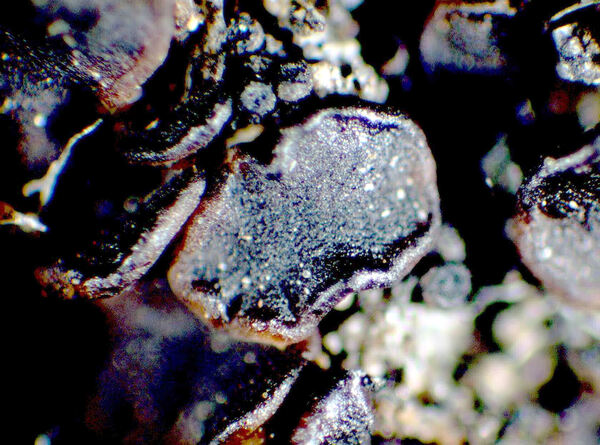Bryonora curvescens (Mudd) Poelt
Nova Hedwigia, 38: 93, 1983. Basionym: Pannaria curvescens Mudd - Man. Brit. Lich.: 125, 1861.
Synonyms: Biatora curvescens Th. Fr.; Lecania curvescens (Mudd) A.L. Sm.; Lecanora castanea f. curvescens (Mudd) Th. Fr.; Lecanora curvescens (Mudd) Nyl.
Distribution: N - TAA.
Description: Thallus crustose, endosubstratic to thinly episubstratic, often poorly evident, grey to dark grey brown, thin, smooth to granulose. Cortex with crystals arranged in anticlinal rows, visible under polarized light; medulla white, I-. Apothecia zeorine (appearing lecideine), round, sessile, strongly constricted at base, 0.5-1.5(-4) mm across, with a dark brown to blackish brown, initially concave and faintly grey-pruinose, then flat to slightly convex disc, and a concolorous or paler, glossy, thick, smooth, crenulate thalline margin. Thalline exciple cupular, reddish brown in outer part, colourless within, not inspersed with granules; proper exciple poorly developed; epithecium yellowish brown, K-, N-; hymenium colourless, 40-80 μm high, K/I+ blue; paraphyses simple, distinctly thickened above, coherent, the apical cells brown-capped. Asci 8-spored, broadly clavate, the K/I+ blue tholus penetrated by a faintly amyloid apical cushion with parallel or diverging flanks, the wall K/I-, surrounded by a K/I+ blue outer layer, Lecanora-type. Ascospores 0(-2-6)-septate (the septa unclear in squash preparations), hyaline, ellipsoid-cylindrical, thick-walled, straight to curved, (20-)29-39(-42) x (4-)5-6.5(-8) μm. Photobiont chlorococcoid. Spot tests: thallus K- or K+ reddish brown (needle-like crystals), C-, KC-, P- or P+ pale yellow, UV-. Chemistry: variable amounts of norstictic acid.Note: an arctic-alpine, circumpolar lichen found on bryophytes (e.g. Andreaea, Grimmia) in sites with periodic seepage of water, with optimum above treeline on siliceous substrata, with a few scattered records from the Alps.
Growth form: Crustose
Substrata: soil, terricolous mosses, and plant debris
Photobiont: green algae other than Trentepohlia
Reproductive strategy: mainly sexual
Commonnes-rarity: (info)
Alpine belt: rare
Subalpine belt: very rare
Oromediterranean belt: absent
Montane belt: absent
Submediterranean belt: absent
Padanian area: absent
Humid submediterranean belt: absent
Humid mediterranean belt: absent
Dry mediterranean belt: absent

Predictive model
Growth form: Crustose
Substrata: soil, terricolous mosses, and plant debris
Photobiont: green algae other than Trentepohlia
Reproductive strategy: mainly sexual
Commonnes-rarity: (info)
Alpine belt: rare
Subalpine belt: very rare
Oromediterranean belt: absent
Montane belt: absent
Submediterranean belt: absent
Padanian area: absent
Humid submediterranean belt: absent
Humid mediterranean belt: absent
Dry mediterranean belt: absent

Predictive model
 INDEX FUNGORUM
INDEX FUNGORUM
 GBIF
GBIF
 DOLICHENS
DOLICHENS




